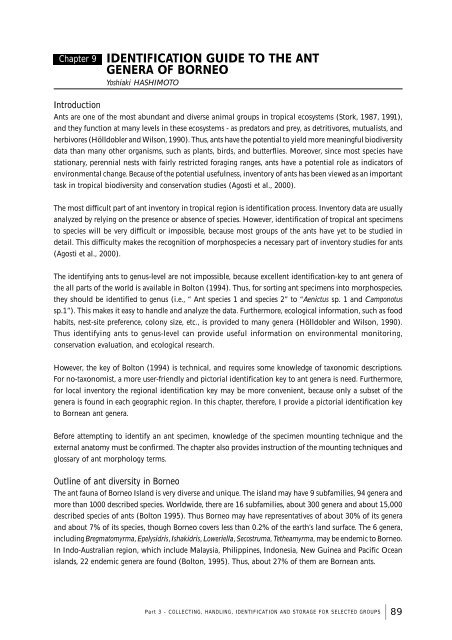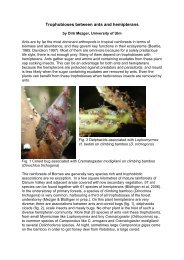Identification guide to the ant genera of Borneo - AntBase.net
Identification guide to the ant genera of Borneo - AntBase.net
Identification guide to the ant genera of Borneo - AntBase.net
Create successful ePaper yourself
Turn your PDF publications into a flip-book with our unique Google optimized e-Paper software.
Chapter 9<br />
IDENTIFICATION GUIDE TO THE ANT<br />
GENERA OF BORNEO<br />
Yoshiaki HASHIMOTO<br />
Introduction<br />
Ants are one <strong>of</strong> <strong>the</strong> most abund<strong>ant</strong> and diverse animal groups in tropical ecosystems (S<strong>to</strong>rk, 1987, 1991),<br />
and <strong>the</strong>y function at many levels in <strong>the</strong>se ecosystems - as preda<strong>to</strong>rs and prey, as detritivores, mutualists, and<br />
herbivores (Hölldobler and Wilson, 1990). Thus, <strong>ant</strong>s have <strong>the</strong> potential <strong>to</strong> yield more meaningful biodiversity<br />
data than many o<strong>the</strong>r organisms, such as pl<strong>ant</strong>s, birds, and butterflies. Moreover, since most species have<br />
stationary, perennial nests with fairly restricted foraging ranges, <strong>ant</strong>s have a potential role as indica<strong>to</strong>rs <strong>of</strong><br />
environmental change. Because <strong>of</strong> <strong>the</strong> potential usefulness, inven<strong>to</strong>ry <strong>of</strong> <strong>ant</strong>s has been viewed as an import<strong>ant</strong><br />
task in tropical biodiversity and conservation studies (Agosti et al., 2000).<br />
The most difficult part <strong>of</strong> <strong>ant</strong> inven<strong>to</strong>ry in tropical region is identification process. Inven<strong>to</strong>ry data are usually<br />
analyzed by relying on <strong>the</strong> presence or absence <strong>of</strong> species. However, identification <strong>of</strong> tropical <strong>ant</strong> specimens<br />
<strong>to</strong> species will be very difficult or impossible, because most groups <strong>of</strong> <strong>the</strong> <strong>ant</strong>s have yet <strong>to</strong> be studied in<br />
detail. This difficulty makes <strong>the</strong> recognition <strong>of</strong> morphospecies a necessary part <strong>of</strong> inven<strong>to</strong>ry studies for <strong>ant</strong>s<br />
(Agosti et al., 2000).<br />
The identifying <strong>ant</strong>s <strong>to</strong> genus-level are not impossible, because excellent identification-key <strong>to</strong> <strong>ant</strong> <strong>genera</strong> <strong>of</strong><br />
<strong>the</strong> all parts <strong>of</strong> <strong>the</strong> world is available in Bol<strong>to</strong>n (1994). Thus, for sorting <strong>ant</strong> specimens in<strong>to</strong> morphospecies,<br />
<strong>the</strong>y should be identified <strong>to</strong> genus (i.e., “ Ant species 1 and species 2” <strong>to</strong> “Aenictus sp. 1 and Camponotus<br />
sp.1”). This makes it easy <strong>to</strong> handle and analyze <strong>the</strong> data. Fur<strong>the</strong>rmore, ecological information, such as food<br />
habits, nest-site preference, colony size, etc., is provided <strong>to</strong> many <strong>genera</strong> (Hölldobler and Wilson, 1990).<br />
Thus identifying <strong>ant</strong>s <strong>to</strong> genus-level can provide useful information on environmental moni<strong>to</strong>ring,<br />
conservation evaluation, and ecological research.<br />
However, <strong>the</strong> key <strong>of</strong> Bol<strong>to</strong>n (1994) is technical, and requires some knowledge <strong>of</strong> taxonomic descriptions.<br />
For no-taxonomist, a more user-friendly and pic<strong>to</strong>rial identification key <strong>to</strong> <strong>ant</strong> <strong>genera</strong> is need. Fur<strong>the</strong>rmore,<br />
for local inven<strong>to</strong>ry <strong>the</strong> regional identification key may be more convenient, because only a subset <strong>of</strong> <strong>the</strong><br />
<strong>genera</strong> is found in each geographic region. In this chapter, <strong>the</strong>refore, I provide a pic<strong>to</strong>rial identification key<br />
<strong>to</strong> Bornean <strong>ant</strong> <strong>genera</strong>.<br />
Before attempting <strong>to</strong> identify an <strong>ant</strong> specimen, knowledge <strong>of</strong> <strong>the</strong> specimen mounting technique and <strong>the</strong><br />
external ana<strong>to</strong>my must be confirmed. The chapter also provides instruction <strong>of</strong> <strong>the</strong> mounting techniques and<br />
glossary <strong>of</strong> <strong>ant</strong> morphology terms.<br />
Outline <strong>of</strong> <strong>ant</strong> diversity in <strong>Borneo</strong><br />
The <strong>ant</strong> fauna <strong>of</strong> <strong>Borneo</strong> Island is very diverse and unique. The island may have 9 subfamilies, 94 <strong>genera</strong> and<br />
more than 1000 described species. Worldwide, <strong>the</strong>re are 16 subfamilies, about 300 <strong>genera</strong> and about 15,000<br />
described species <strong>of</strong> <strong>ant</strong>s (Bol<strong>to</strong>n 1995). Thus <strong>Borneo</strong> may have representatives <strong>of</strong> about 30% <strong>of</strong> its <strong>genera</strong><br />
and about 7% <strong>of</strong> its species, though <strong>Borneo</strong> covers less than 0.2% <strong>of</strong> <strong>the</strong> earth’s land surface. The 6 <strong>genera</strong>,<br />
including Bregma<strong>to</strong>myrma, Epelysidris, Ishakidris, Loweriella, Secostruma, Te<strong>the</strong>amyrma, may be endemic <strong>to</strong> <strong>Borneo</strong>.<br />
In Indo-Australian region, which include Malaysia, Philippines, Indonesia, New Guinea and Pacific Ocean<br />
islands, 22 endemic <strong>genera</strong> are found (Bol<strong>to</strong>n, 1995). Thus, about 27% <strong>of</strong> <strong>the</strong>m are Bornean <strong>ant</strong>s.<br />
Part 3 - COLLECTING, HANDLING, IDENTIFICATION AND STORAGE FOR SELECTED GROUPS<br />
89




